Mount Everest (original) (raw)
Located in the northern part of the Indian subcontinent in Asia, the Himalayas is a long mountain range that forms a formidable barrier between the Tibetan Plateau and the alluvial plains of the Indian subcontinent. Mount Everest, the world's highest peak, is located in the Mahalangur Himal subrange of the Himalayas. It lies on the boundary between the Tibet Autonomous Region of China and Nepal. Rising to an elevation of 8,848.86m, Mount Everest is the most prominent peak among the Seven Summits of the World.
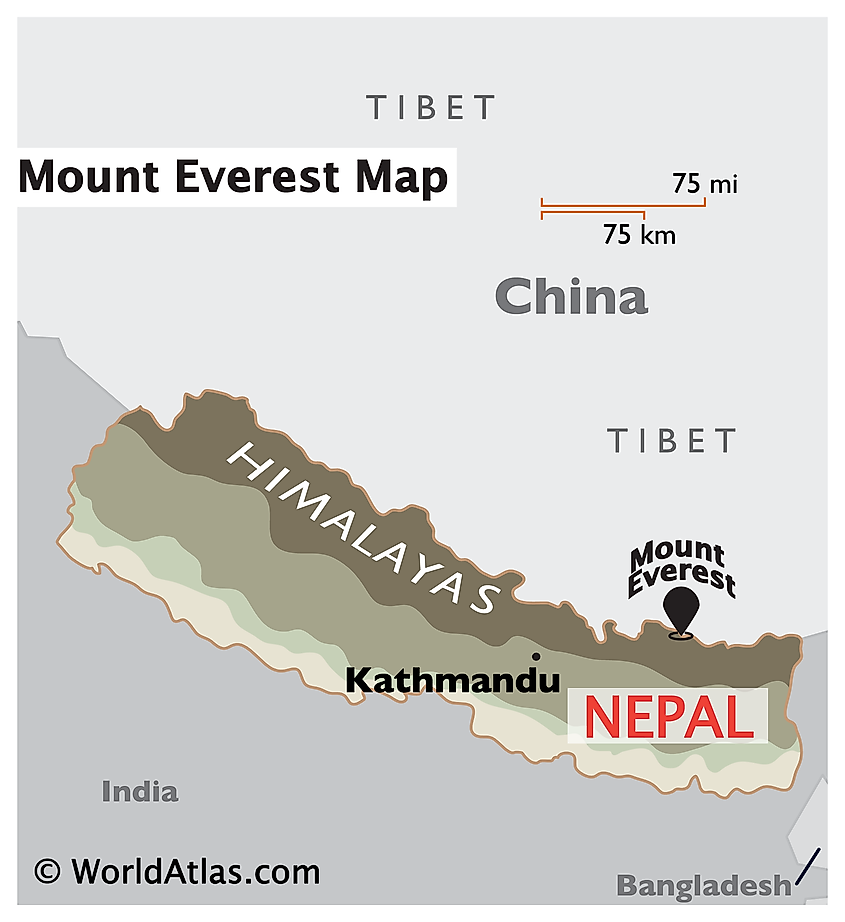
Map showing the location of Mount Everest at the Nepal-China border.
Geography
It is believed that the Himalayan ranges were pushed upwards around 50 million years ago, as a result of the subduction of the Indian-Australian tectonic plate under the Eurasian Plate. During the early Miocene Epoch, the increased crunching force between the two collided plates further uplifted the Himalayas to greater heights. During the Pleistocene Epoch, the Greater Himalayas started to take their present form.
Geological studies have revealed that Mount Everest is made up of several layers of rock that have been folded back on themselves forming undulating structures or nappes. The rocks present on the lower elevations of the mountain are made up of metamorphic schists and gneisses that are topped by igneous granites. On the higher elevations, sedimentary rocks are found, that of marine origin, and are believed to be the remnants of the ancient Tethys Sea. Notable among these rocks is the Yellow Band, which is a limestone formation and is visible just beneath the summit pyramid. The rocks that makeup Mount Everest have been further subdivided by geologists into three units that are separated from each other by low-angle faults. From the base to the summit of Mount Everest, these rock units are the Rongbuk Formation, the North Col Formation, and the Qomolangma Formation.
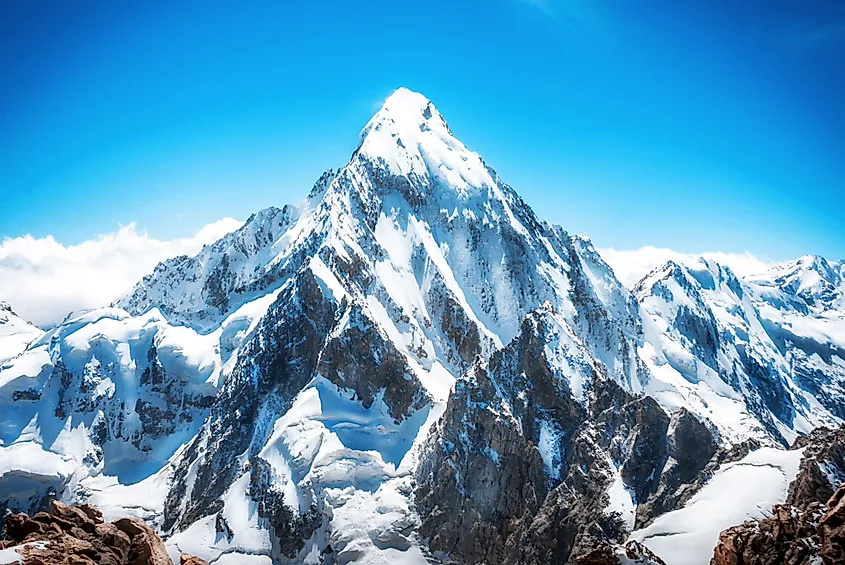
Mount Everest.
The Qomolangma Formation extends from the mountain summit to the top of the Yellow Band at an elevation of 8,600m. It is composed of dark grey or white parallel laminated bands of Ordovician limestone that are further interlayered with beds of dolomite and argillaceous minerals. The Qomolangma Detachment separates the Qomolangma Formation from the underlying Yellow Band. The North Col Formation constitutes the bulk of Mount Everest and is found at elevations between 7,000m and 8,600m. It is mainly composed of layers of schist, phyllite, and marble. Below the North Col Formation, the base of Mount Everest is made up of the Rongbuk Formation.
The slopes of Mount Everest are covered by several glaciers including the Kangshung Glacier, the Rongbuk Glaciers (East, Central, and West), the Pumori Glacier, and the Khumbu Glacier. Several rivers originate from these glaciers such as the Lobujya River which rises from the Khumbu Glacier, the Rong River which rises from the Rongbuk and Pumori glaciers, and the Kama River which originates from the Kangshung Glacier.
Climate
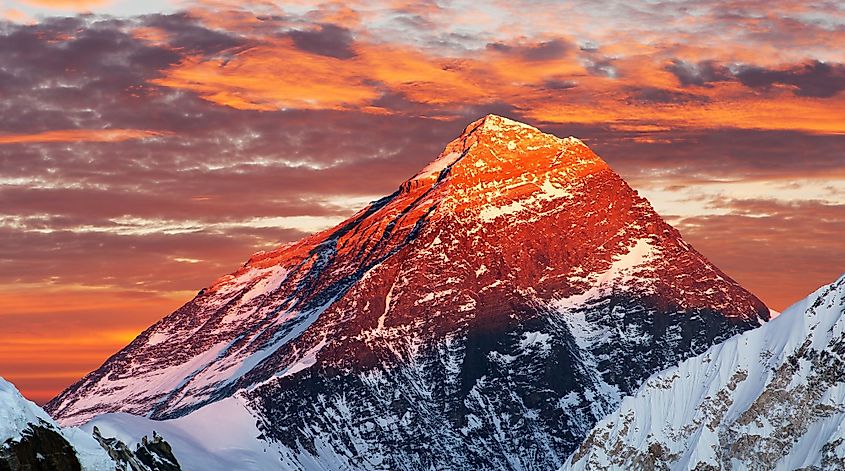
Evening colored view of Mount Everest from the Gokyo Valley.
The warm daytime temperature in July averages only about -2°C at the summit of Mount Everest, while during January, the temperature at the summit averages -36°C and can fall as low as -60°C. Most of the precipitation falls as snow during the summer monsoon from late May to mid-September. The region also experiences sudden storms that can lead to a further drop in the temperatures. The layer of snow on Mount Everest fluctuates annually by 1.5 to 6m and is the highest during September and lowest during May. The mountain summit and the upper slopes of Mount Everest reach a higher level in the Earth’s atmosphere and therefore the amount of oxygen that is available here is about one-third to that in the sea level.
Flora and Fauna
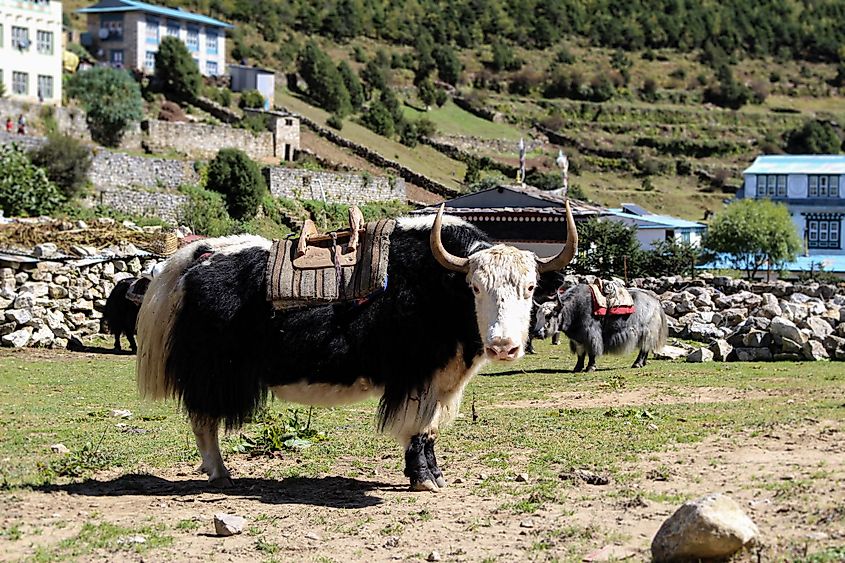
Black White Yak.
The extremely cold temperatures, the strong powerful winds, and the lack of oxygen hinder the growth of plants and the presence of animals in this region. As a result, very few native plants and animals are found here. On the Nepal side of the international border, Mount Everest and its surrounding valleys form a part of the Sagarmatha National Park. Established in 1976, this 1,243 sq. km park supports plant species like rhododendrons, Himalayan Juniper, etc in the alpine habitats. Some of the animals that are found here include the Himalayan jumping spider, yaks, Himalayan tahr, snow leopard, Himalayan black bear, and red panda. Birds like bar-headed geese and yellow-billed choughs are also found. In 1979, the Sagarmatha National Park was designated as a UNESCO World Heritage Site.
Brief History
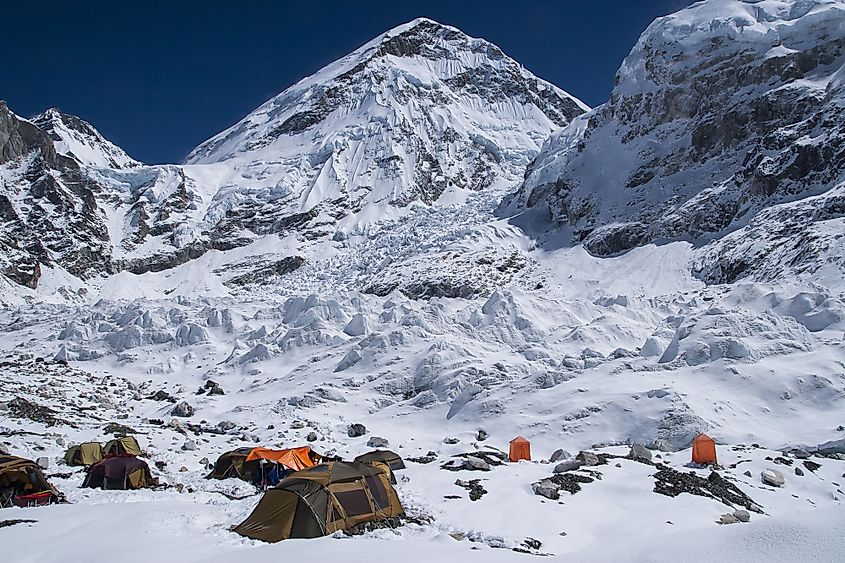
Everest Base Camp, Nepal.
Mount Everest has been revered as a ‘sacred place’ by the local Sherpa people for several centuries. The native people in Tibet refer to the mountain as “Chomolungma” which means “Holy Mother”, while in Chinese, the mountain is referred to as Zhumulangma Feng. The Government of Nepal and the local Nepali people refer to the mountain as “Sagarmatha” which means “the Head in the Great Blue Sky”.
In 1802, the British Government dispatched teams of surveyors for mapping the Indian subcontinent in an expedition that was named the “Great Trigonometrical Survey”. In 1830, this team of surveyors was joined by the geographer George Everest, who came to India to work as a surveyor-general. In 1831, George Everest was in search of a mathematician who had specialized in spherical trigonometry and can be a part of this Great Trigonometrical Survey. An Indian mathematician and surveyor from Bengal named Radhanath Sikdar was then appointed in this post. In 1843, George Everest was succeeded by Colonel Andrew Scott Waugh as the British Surveyor General of India. In 1847, he made several observations and noted a high peak that was located about 230km from Kangchenjunga, which was then considered as the highest peak in the world. One of Waugh’s subordinates – John Armstrong, also saw the peak and named it as peak “b”. James Nicolson was sent by Andrew Waugh in the area in 1849 for obtaining closer observations and calculating the height of the high peak. As per Nicolson’s raw data, the height of the peak “b” was about 9,200m, eventually making it much higher than Kangchenjunga. However, Nicolson was affected by malaria and was forced to return home without finishing his calculations. Michael Hennessy who also worked as Waugh’s assistant named peak “b” as Peak XV.
Using the trigonometric calculations based on Nicolson’s measurements the Indian Mathematician Radhanath Sikdar, calculated the exact height of the peak to be 29,000ft (8,839.2m). But Colonel Andrew Scott Waugh later added 2ft to make it appear at a more credible figure. In 1856, the official height of Peak XV was announced as 29,002 ft (8,839.8m). Sir Andrew Waugh named the Peak XV “Mount Everest” in the honor of his predecessor Sir George Everest. In 1865, the Royal Geographical Society officially declared Mount Everest as the world’s highest mountain.
Climbing History
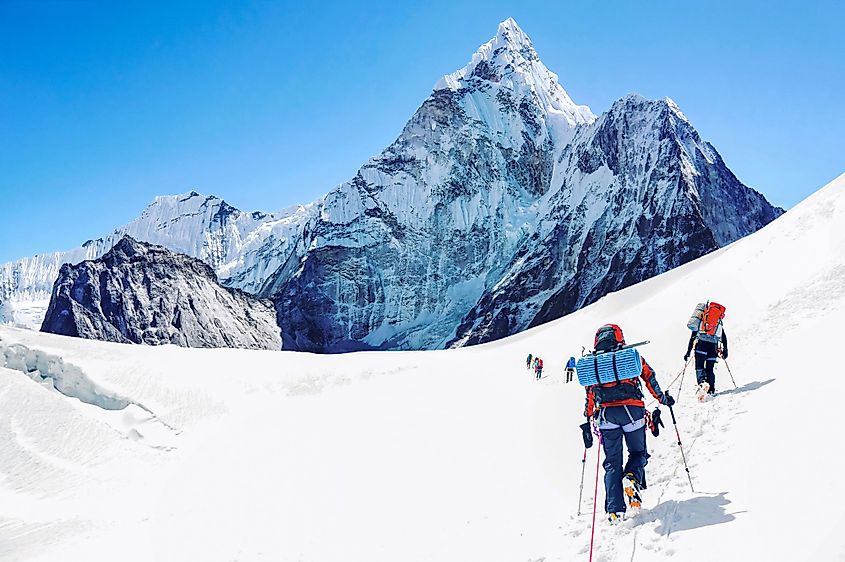
Group of climbers reaching the Everest summit in Nepal.
Being the world’s mountain peak, Mount Everest attracts tourists and climbers from all around the world. On 29th May 1953, the New Zealander Sir Edmund Hillary and the local Nepali Sherpa Tenzing Norgay became the first men to have officially ascended the summit of Mount Everest. The ascent to this highest summit is considered to be extremely difficult and only experienced mountain climbers can ascend the mountain. It is estimated that every year more than 5,000 people attempt to summit the Mountain. As of 2017, it has been recorded that over 7,600 people have reached the Mountain summit and about 300 people have died in their attempts. There are two main climbing routes, one is the southeast ridge from Nepal and the other is the north ridge from Tibet. The climb to the highest summit takes about two months and the climbing season normally starts during mid-May just before the summer monsoon season. However, many obstacles are faced by the climbers which include avalanches, strong winds, altitude sickness, and the risk of frostbite.
Threats
In recent years, it has been found that the Mount Everest region has been severely polluted due to the accumulation of garbage that has been left behind by the climbers. Several tons of non-biodegradable garbage like empty oxygen cylinders, tents, sleeping bags, broken climbing gears, food packaging etc have been found in the mountain region. The lack of proper solid waste management has led to the accumulation of human feces in the mountain snow and climbing trails, which have also resulted in the pollution of the downstream rivers. The corpses of over 280 climbers who have died while climbing Mount Everest have also not been removed. There have also been serious concerns regarding the degradation of the fragile ecosystem of Mount Everest due to the stream of visitors who come to climb the mountain every year.